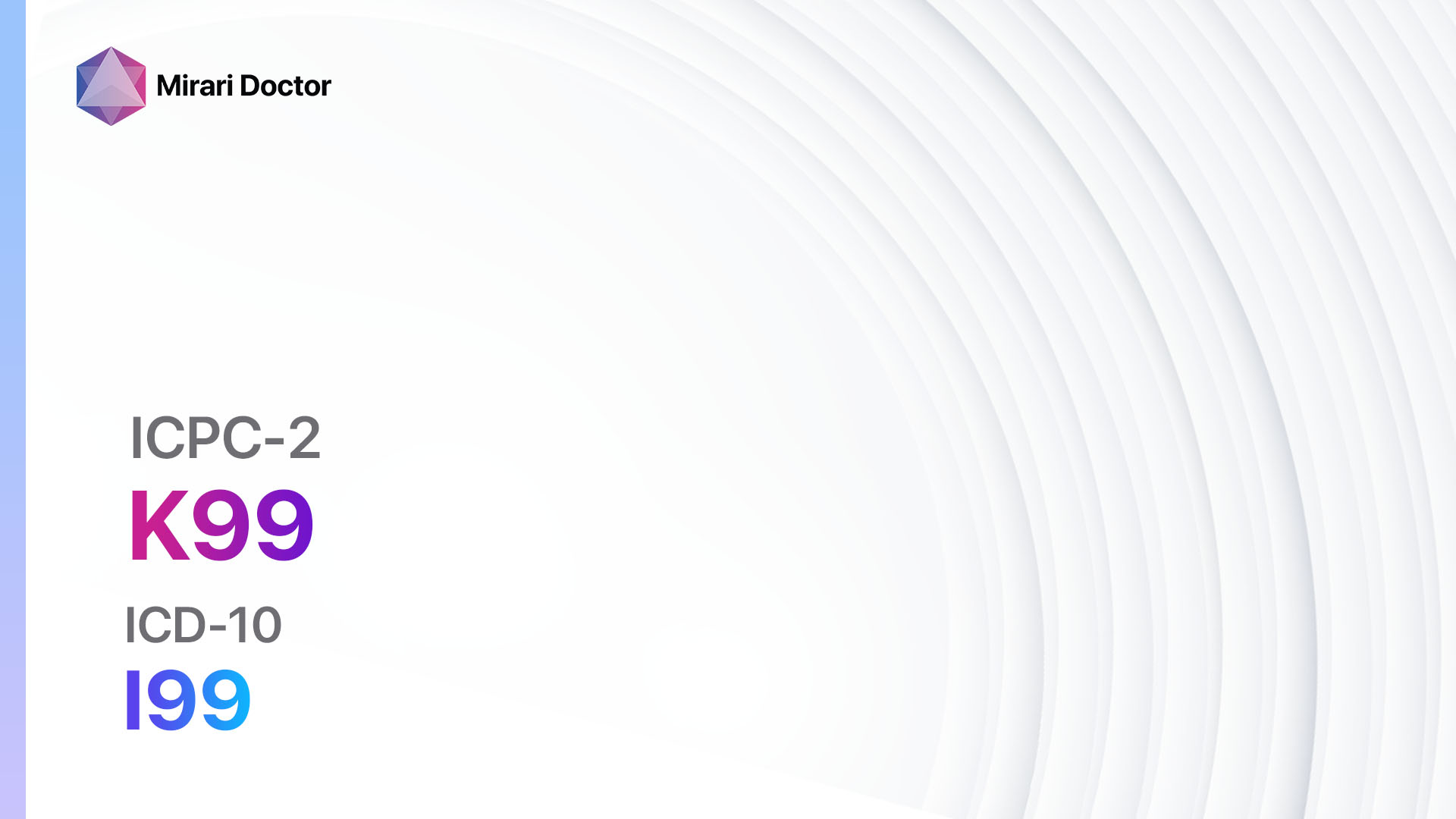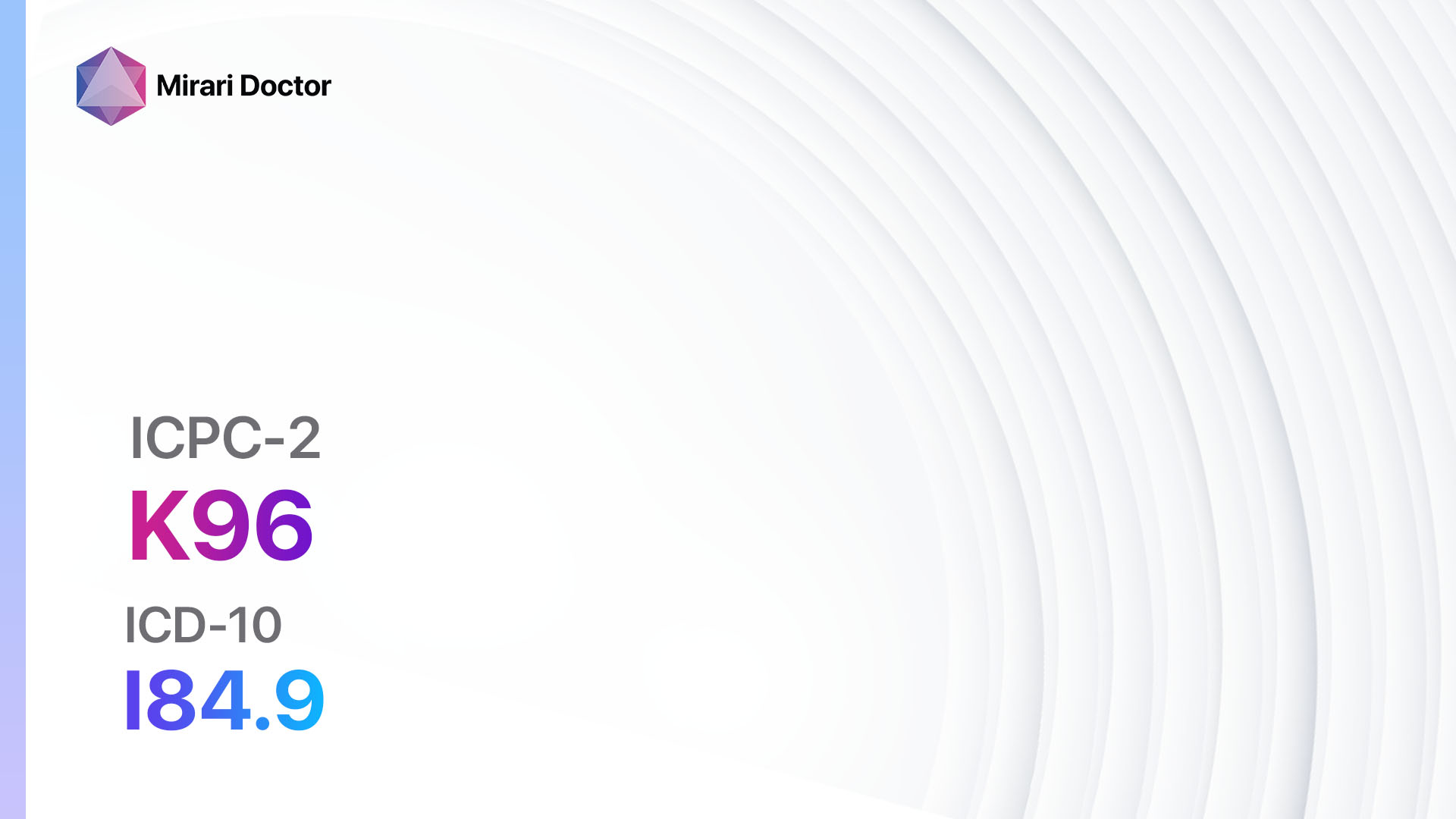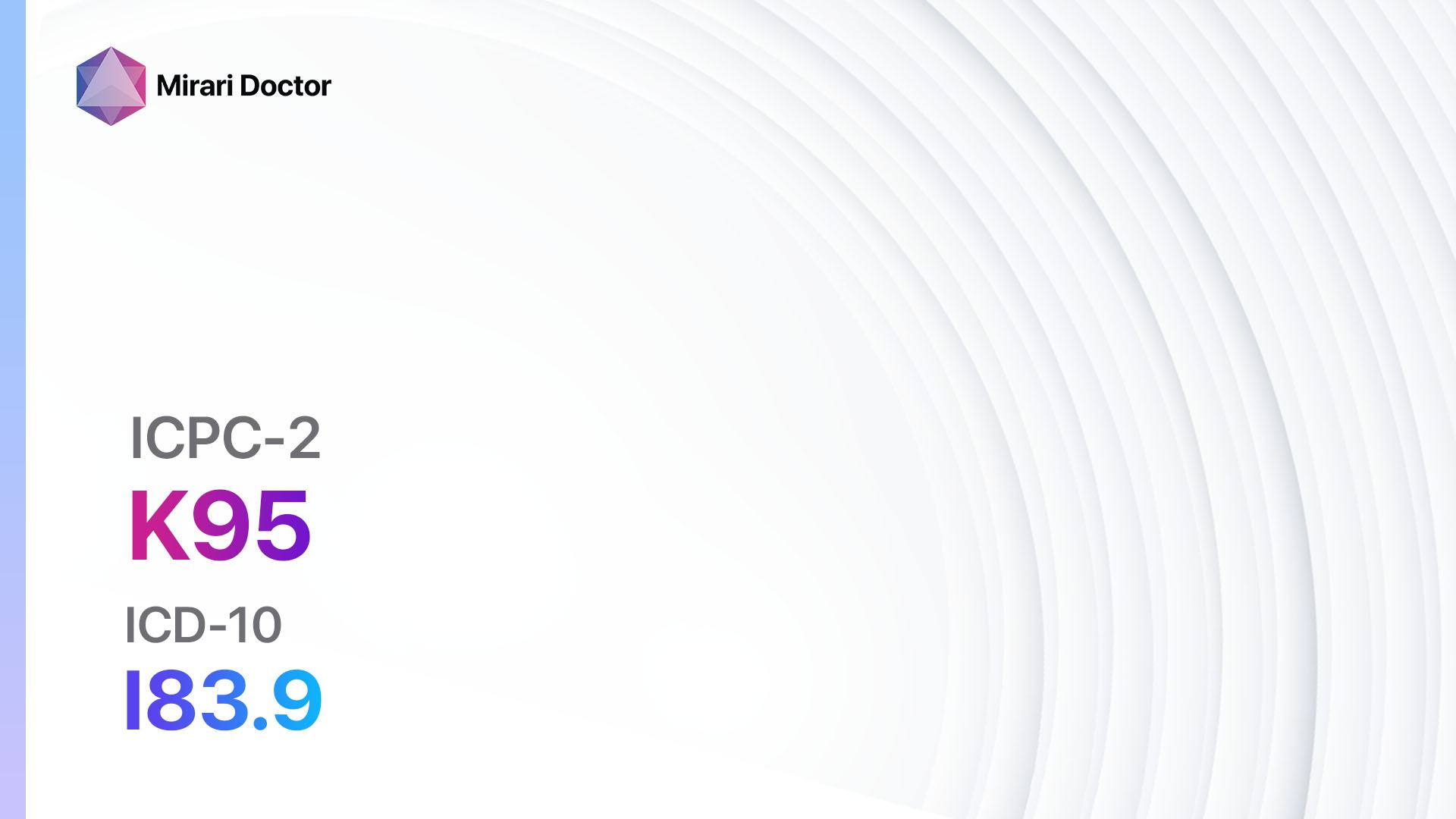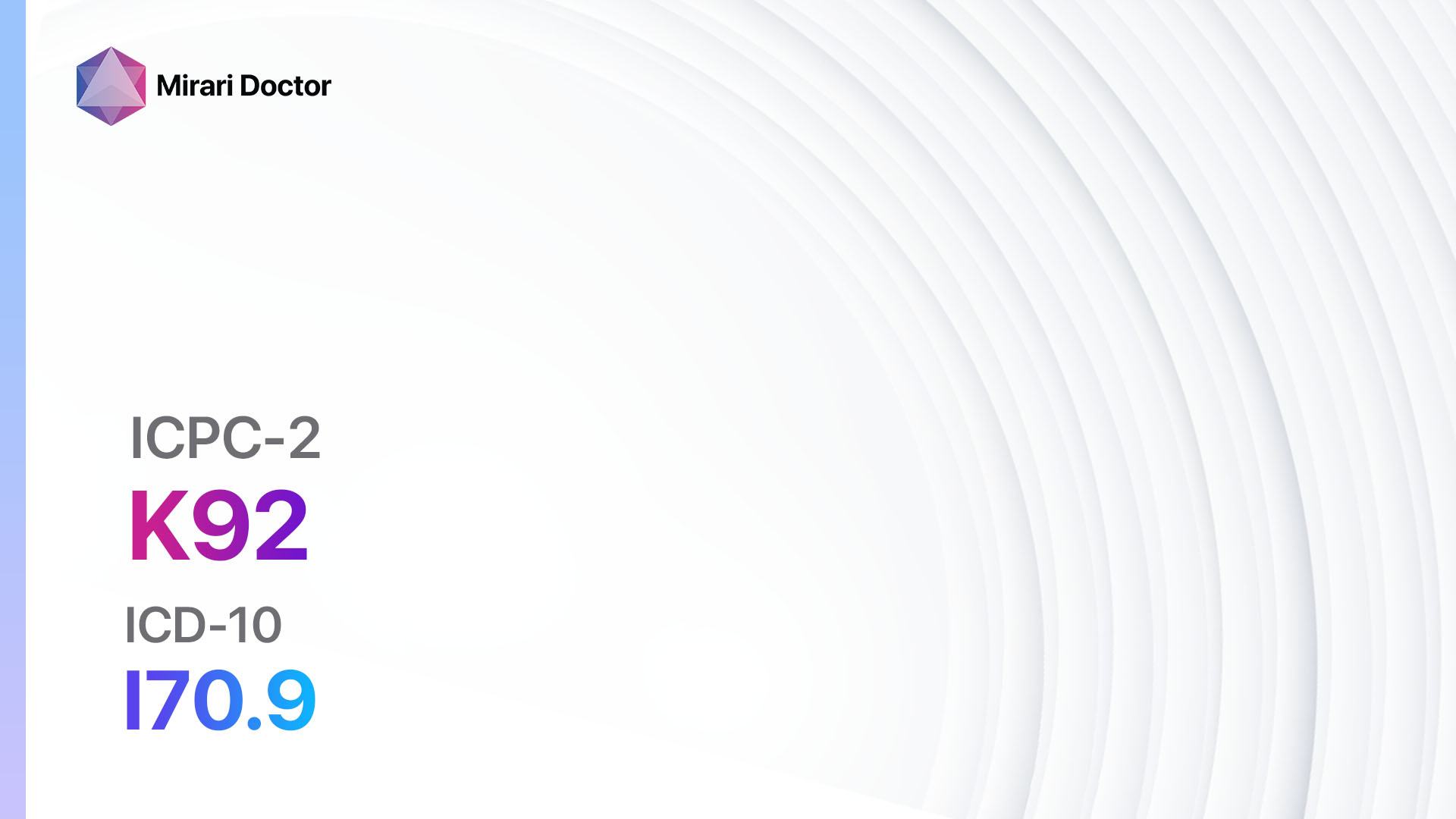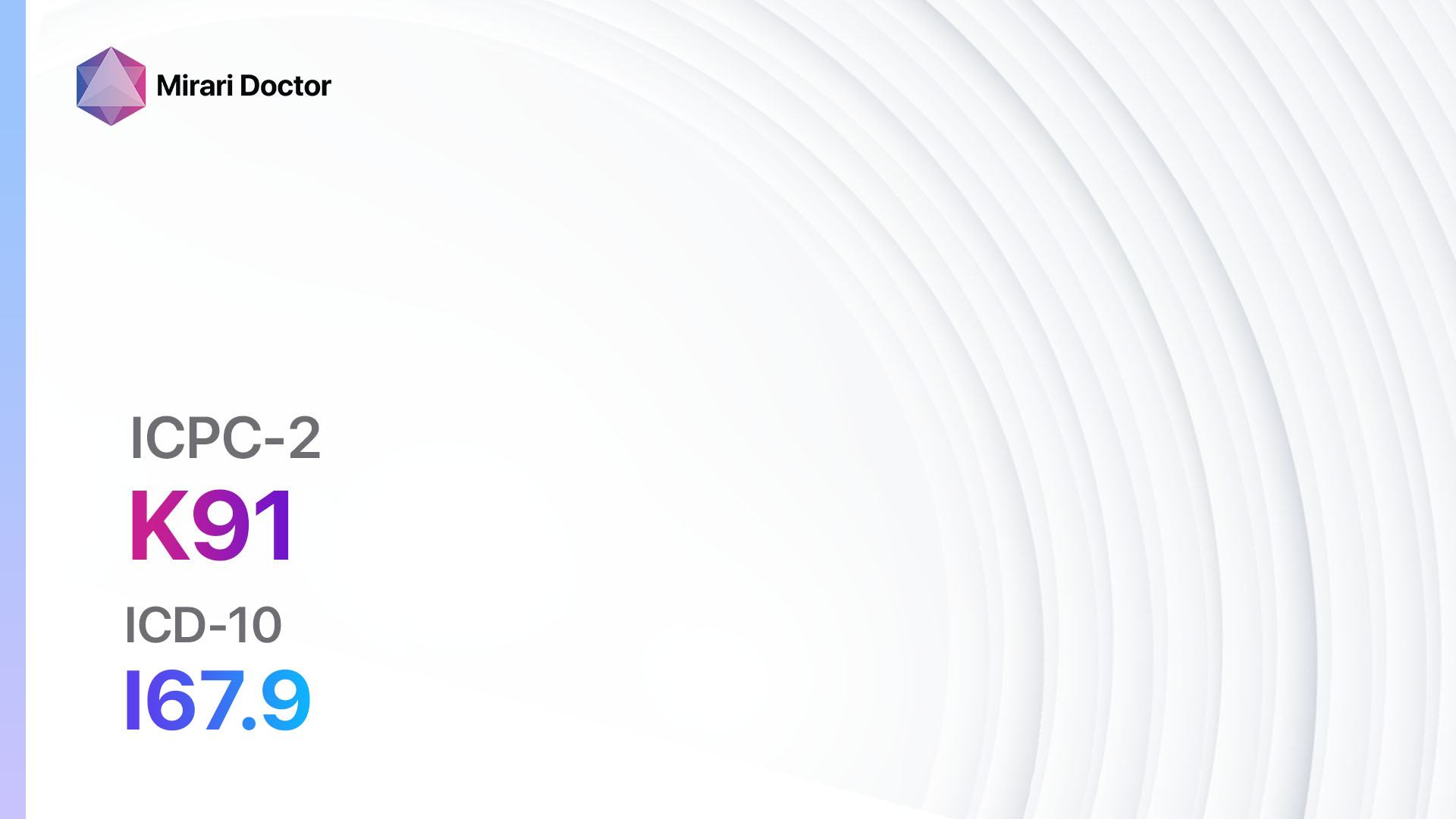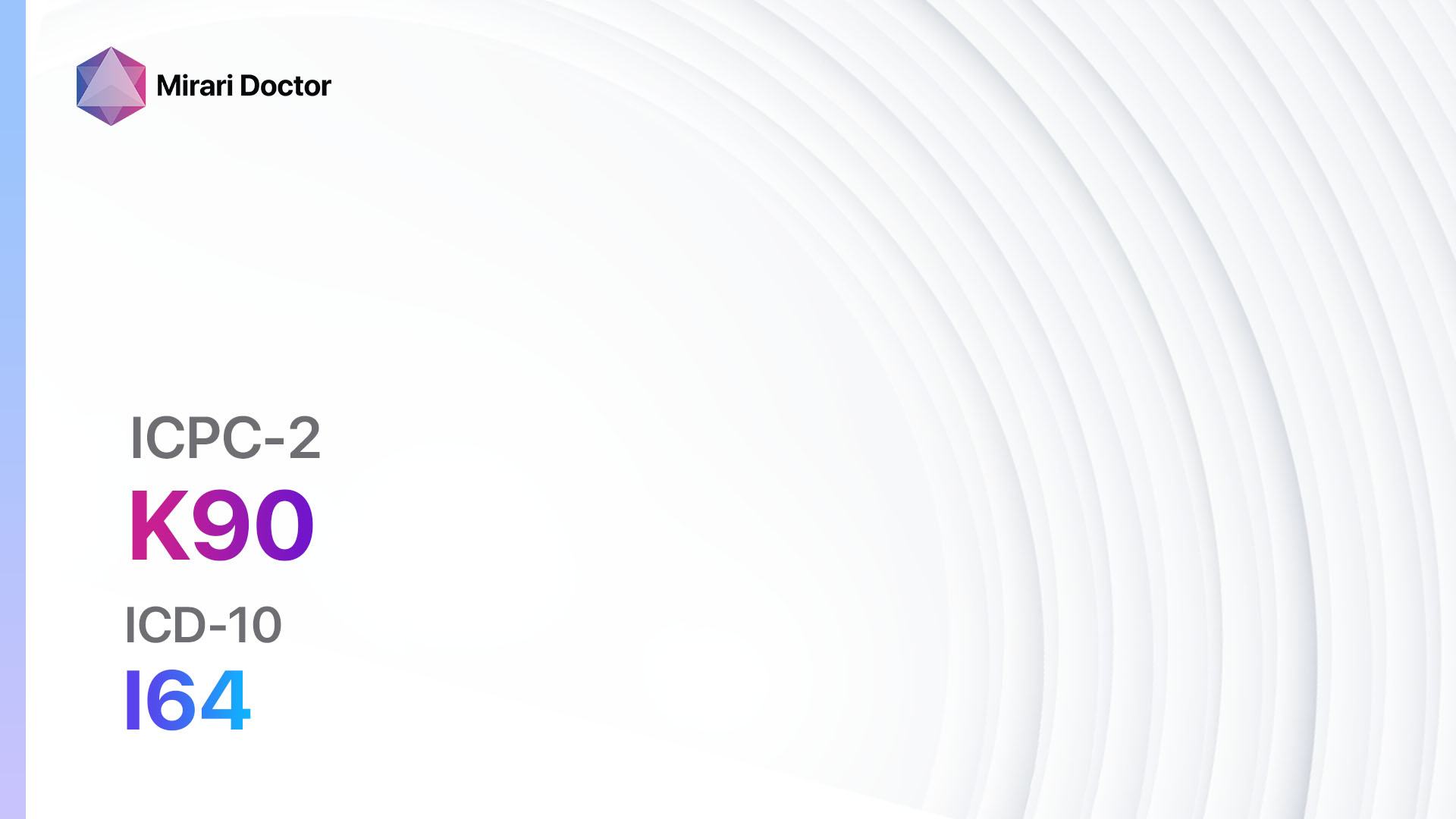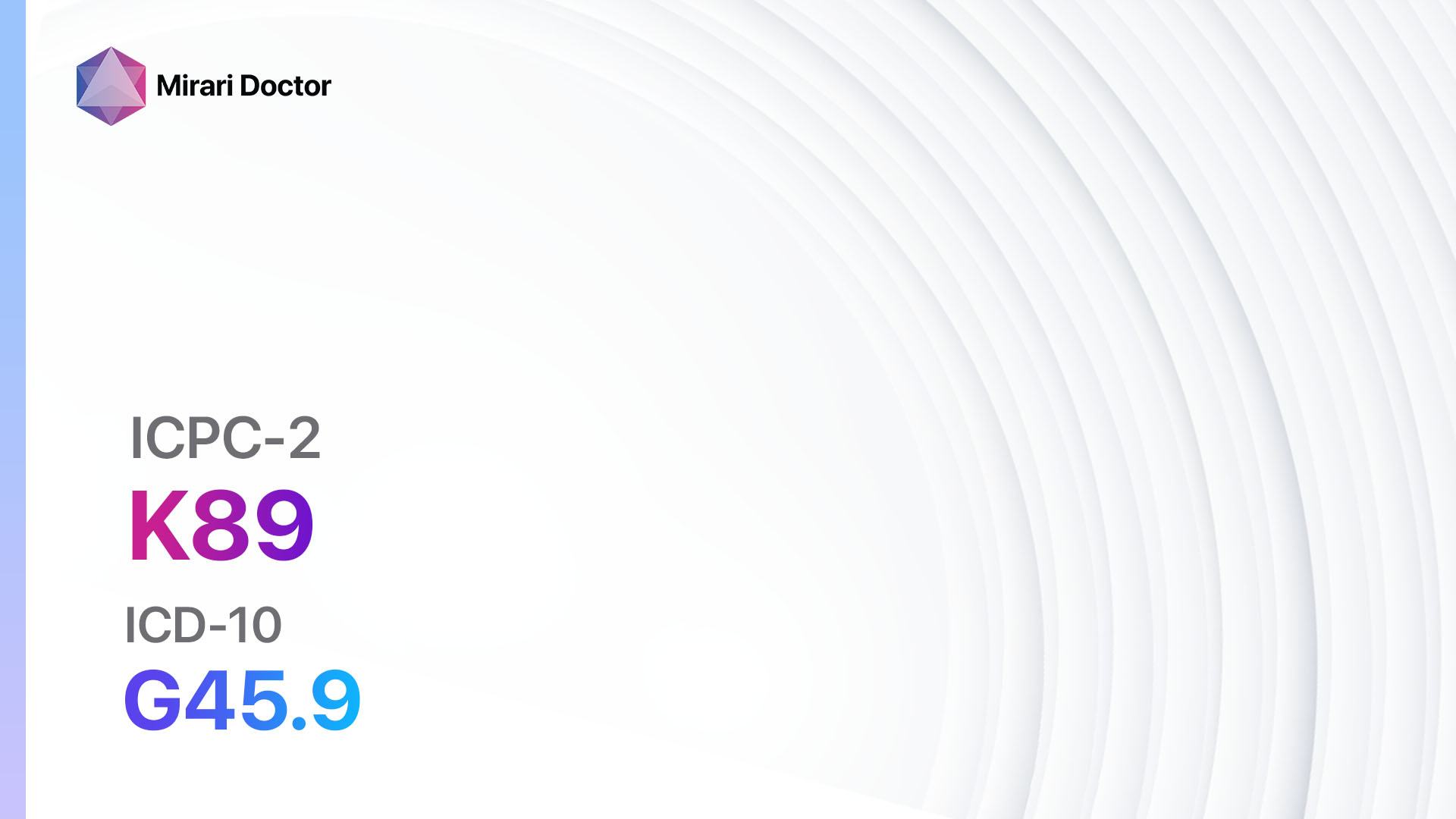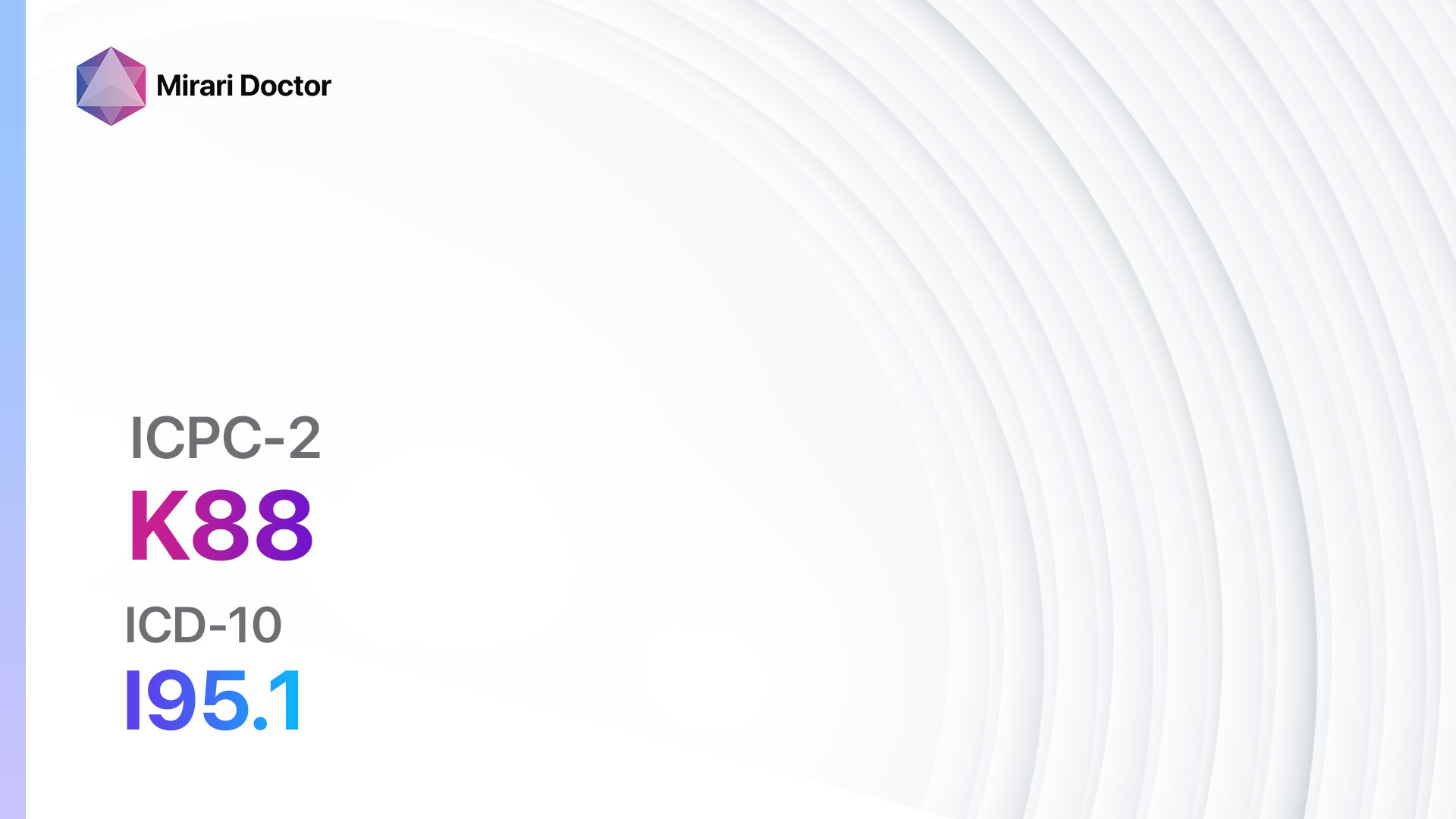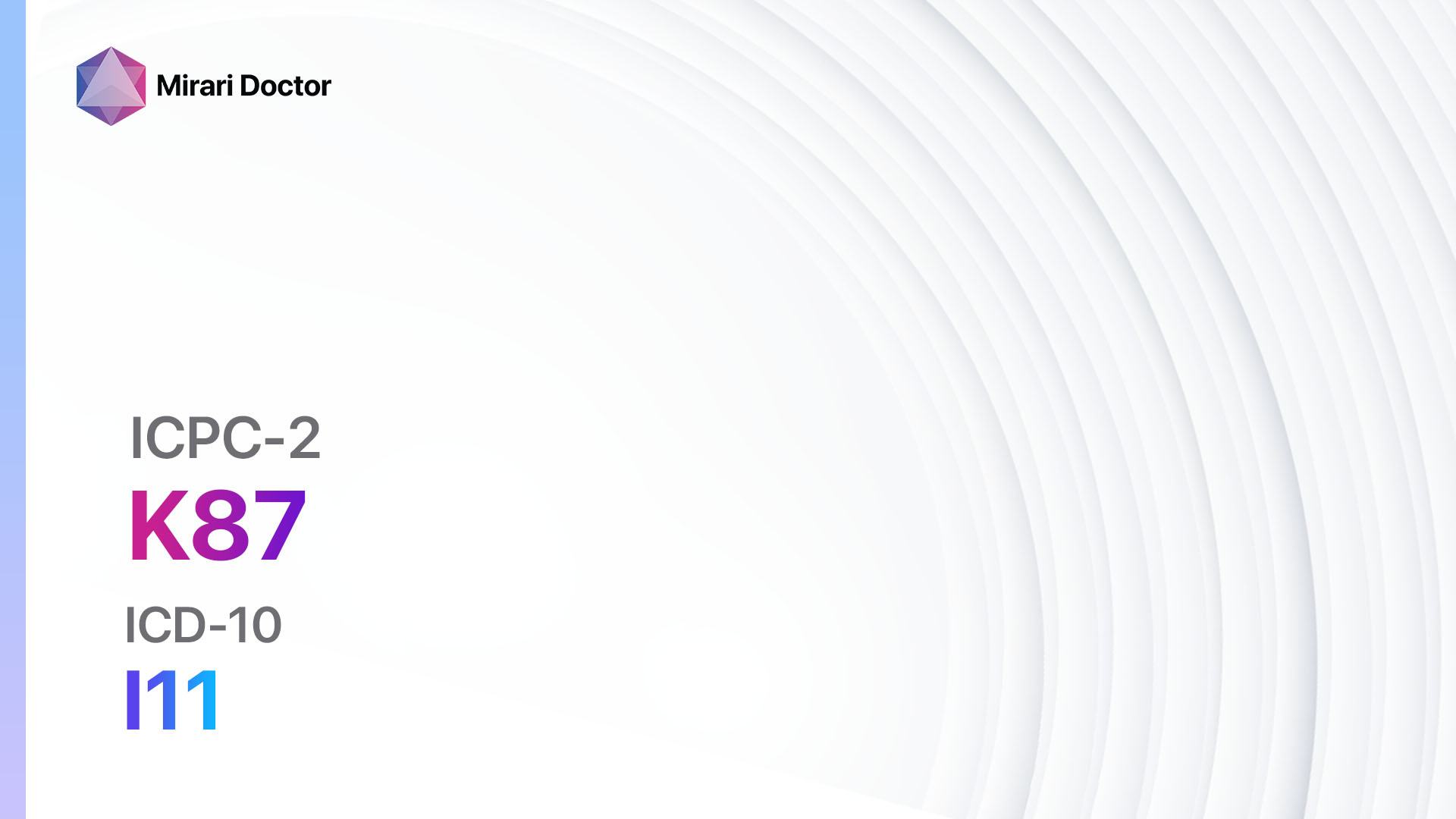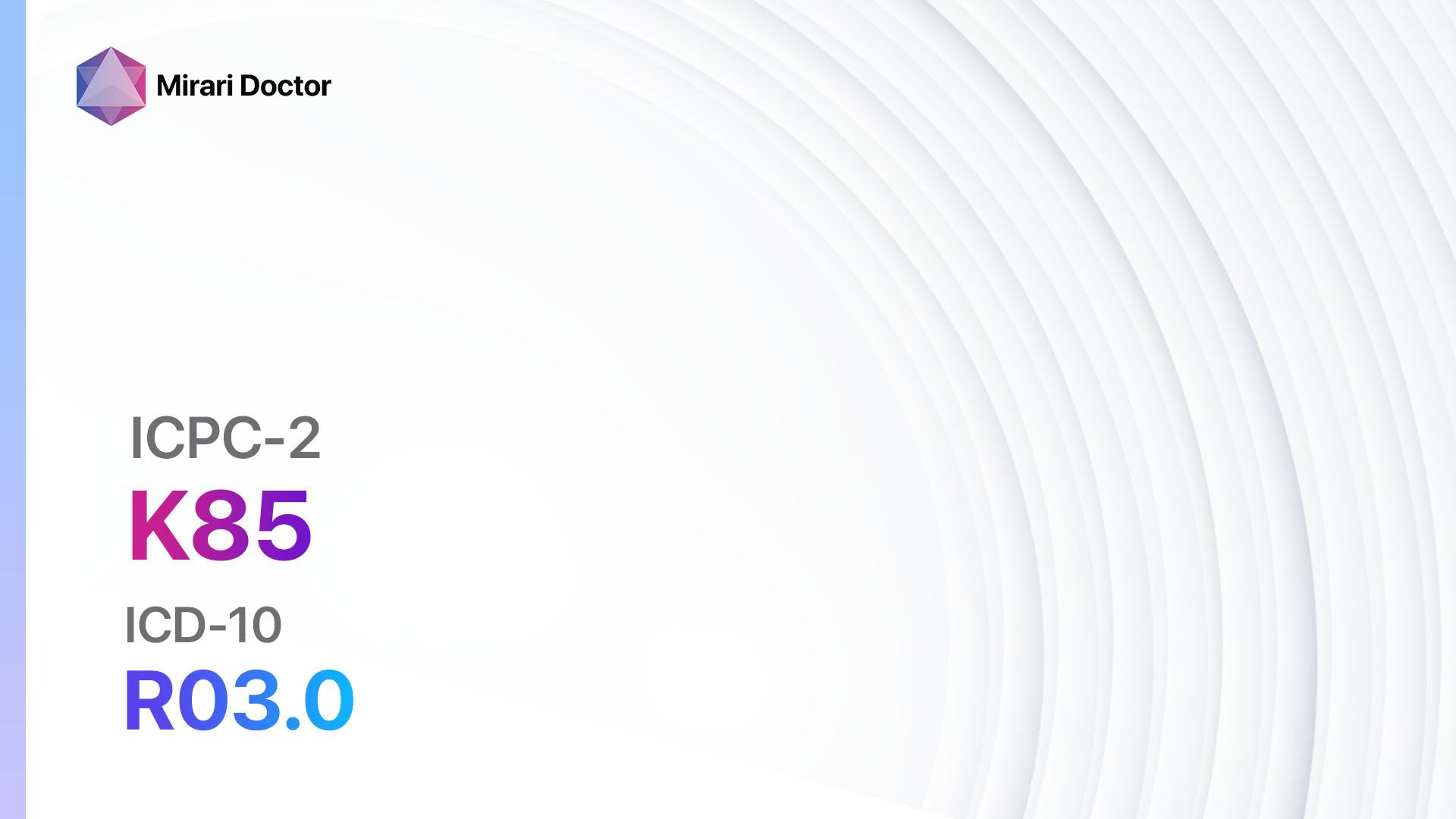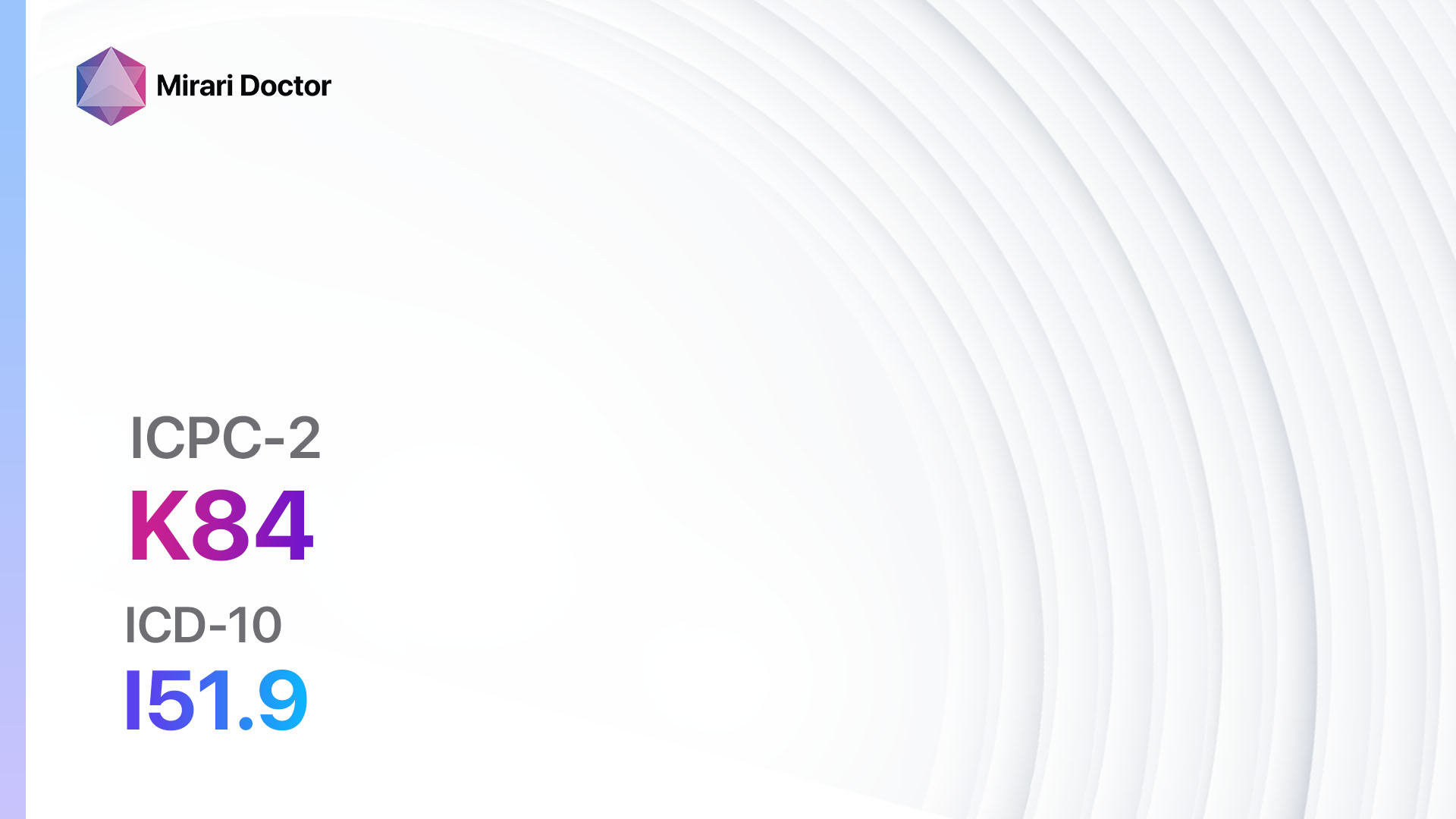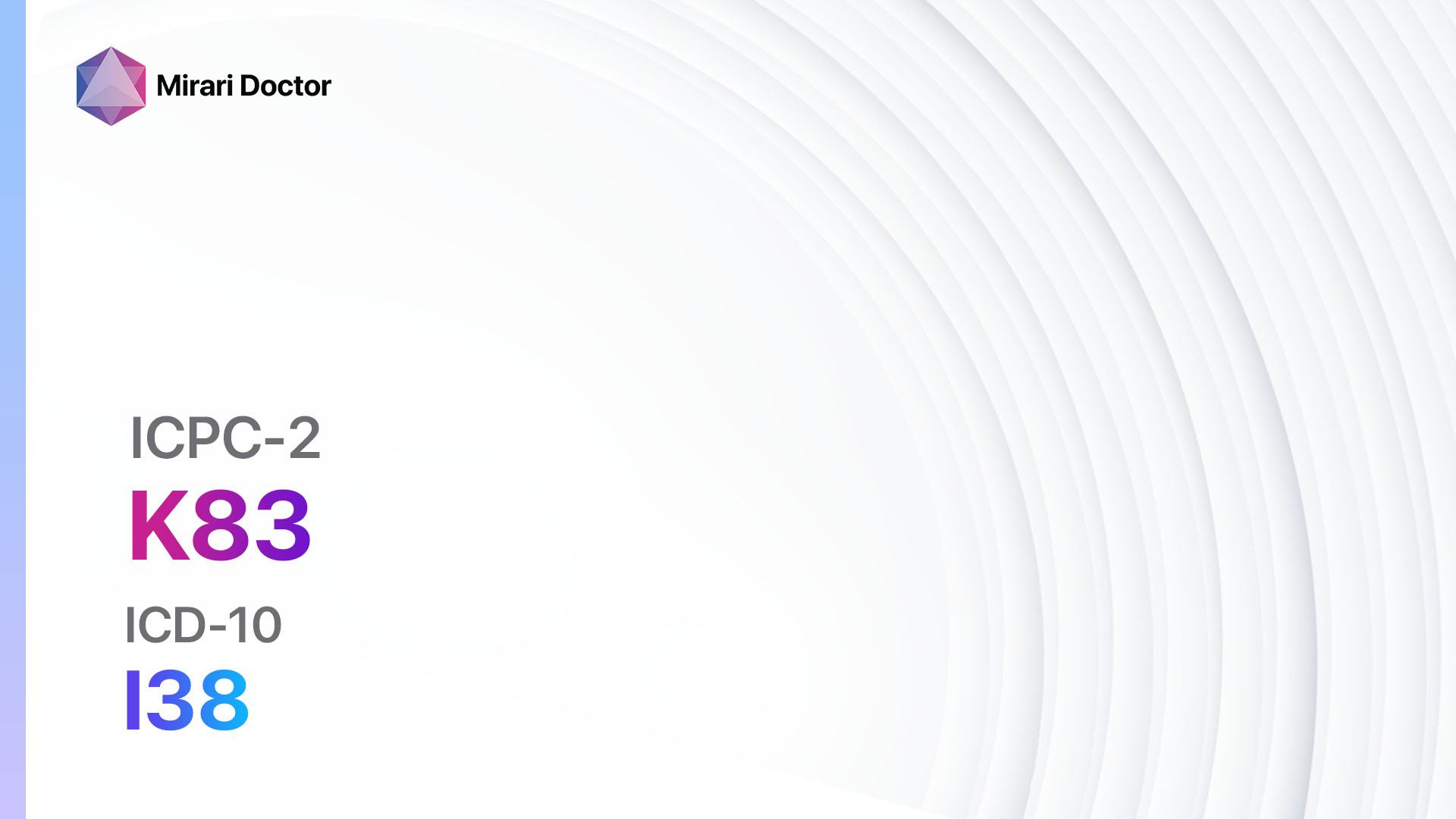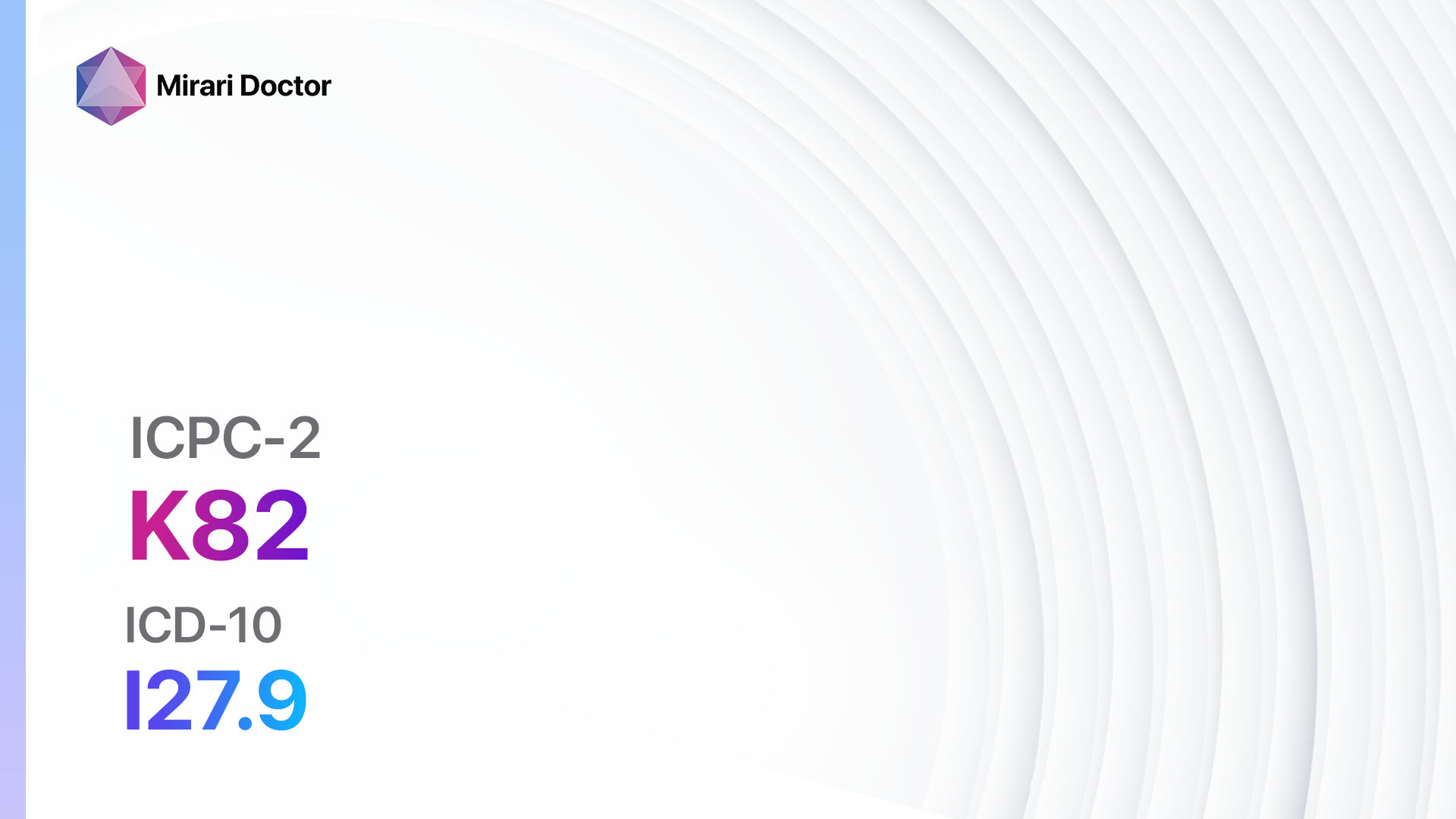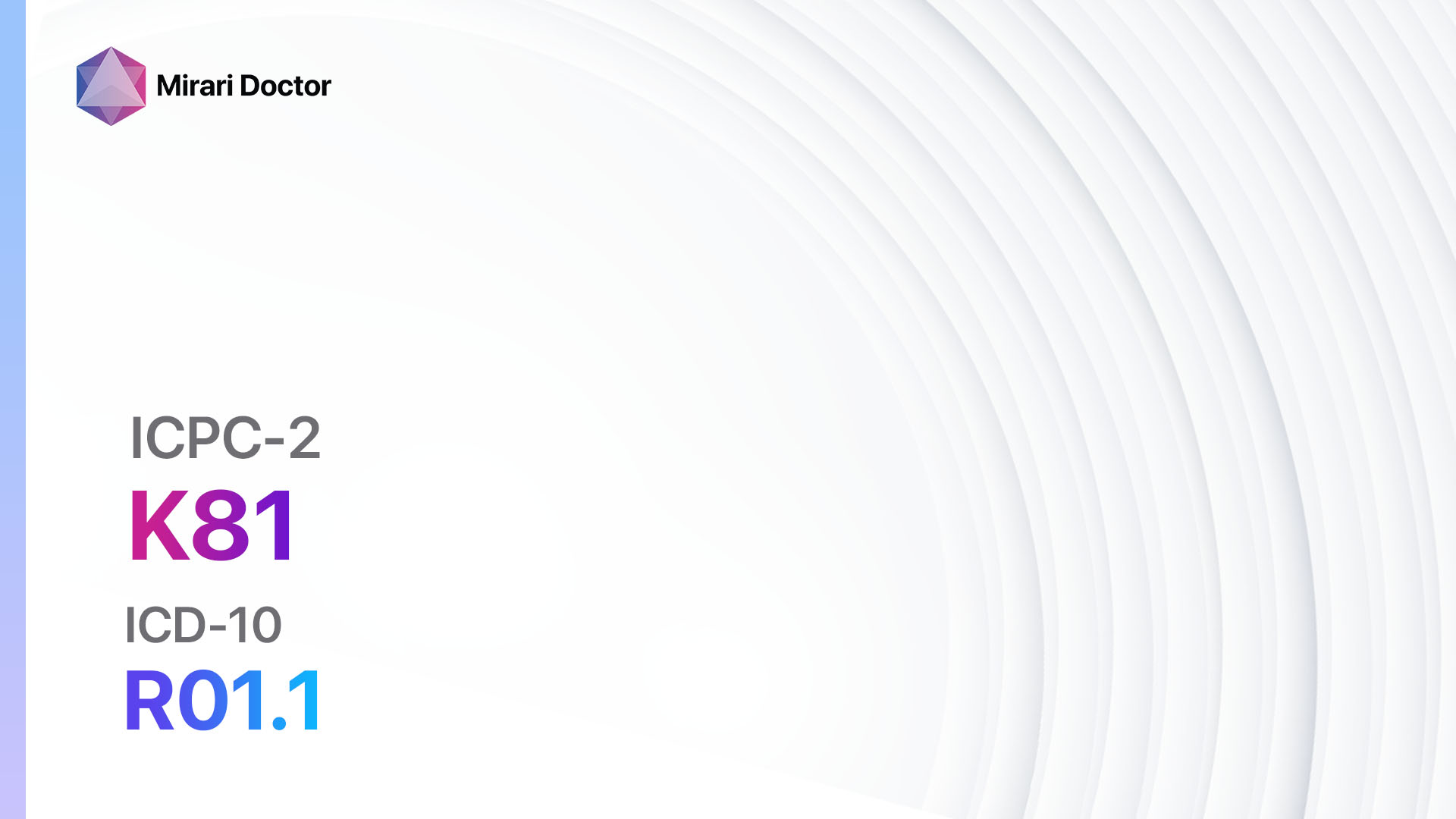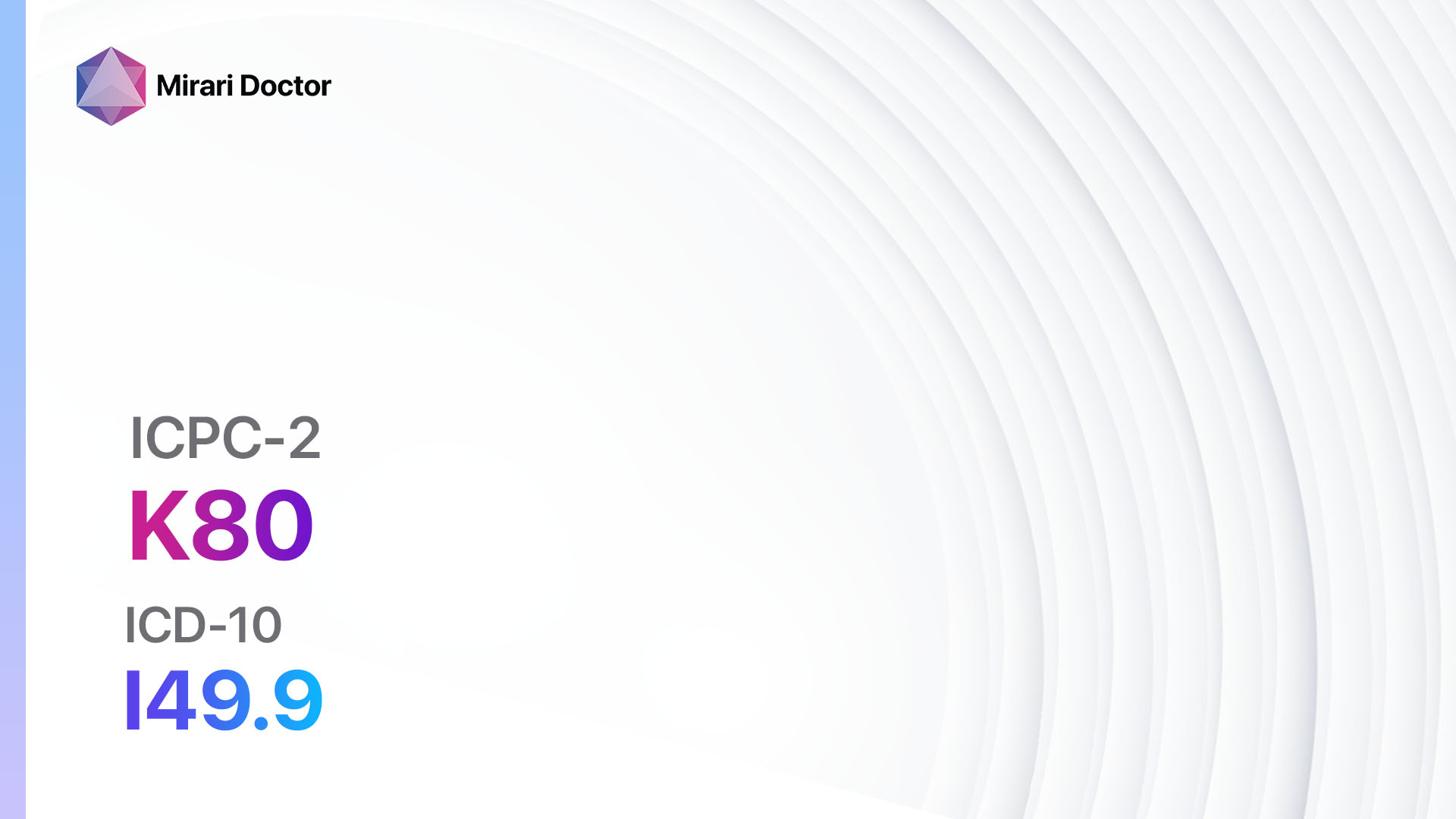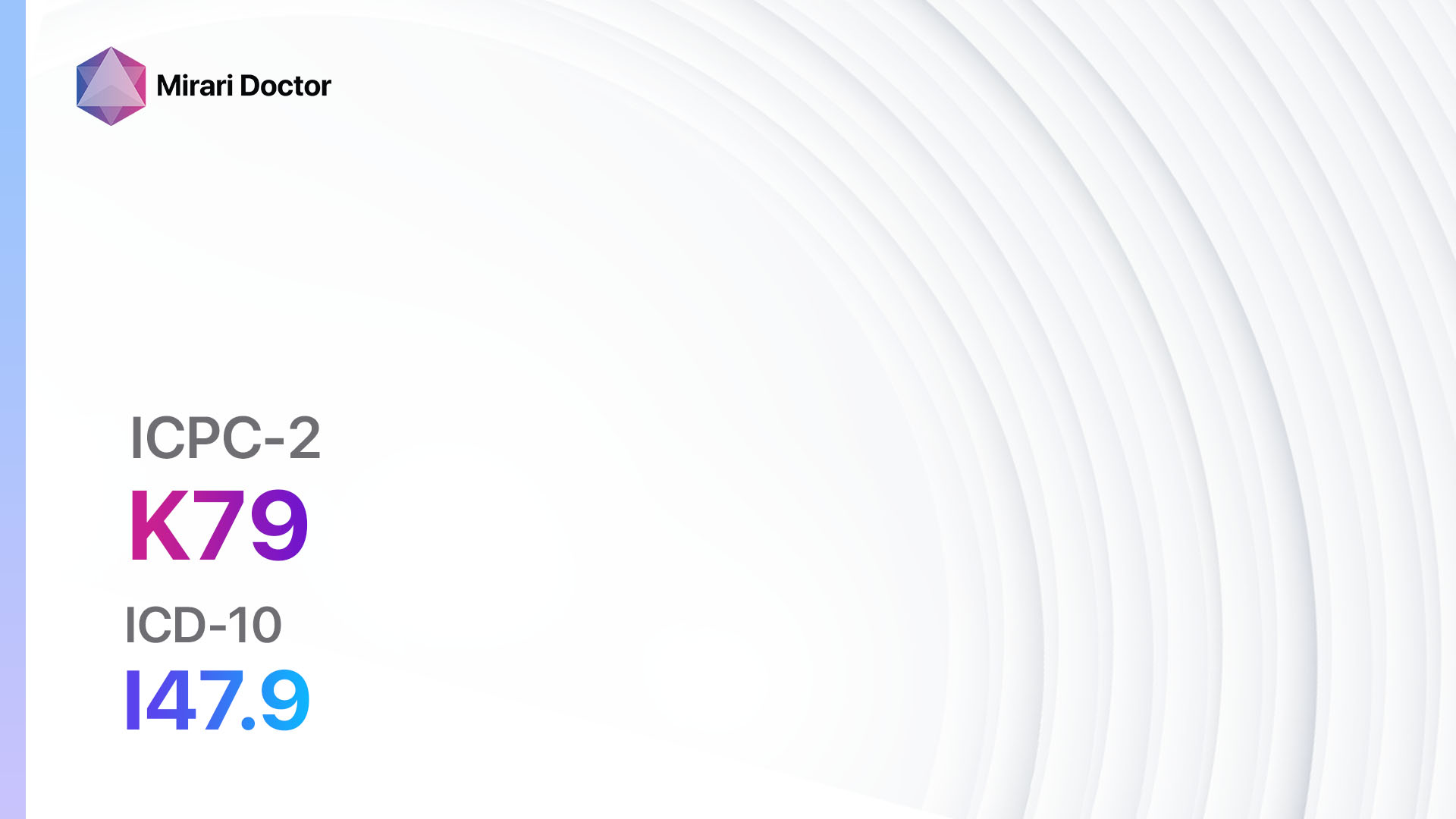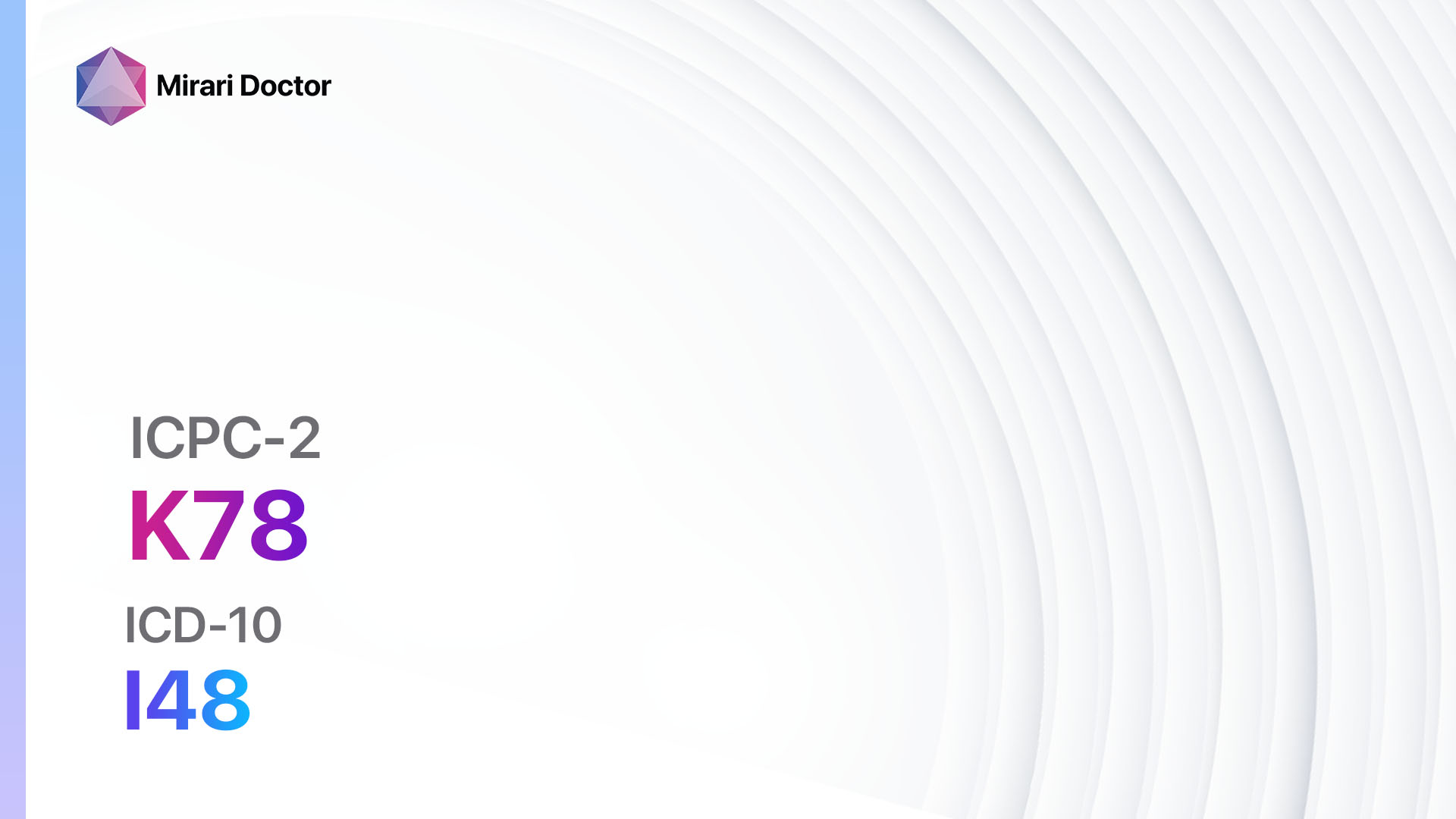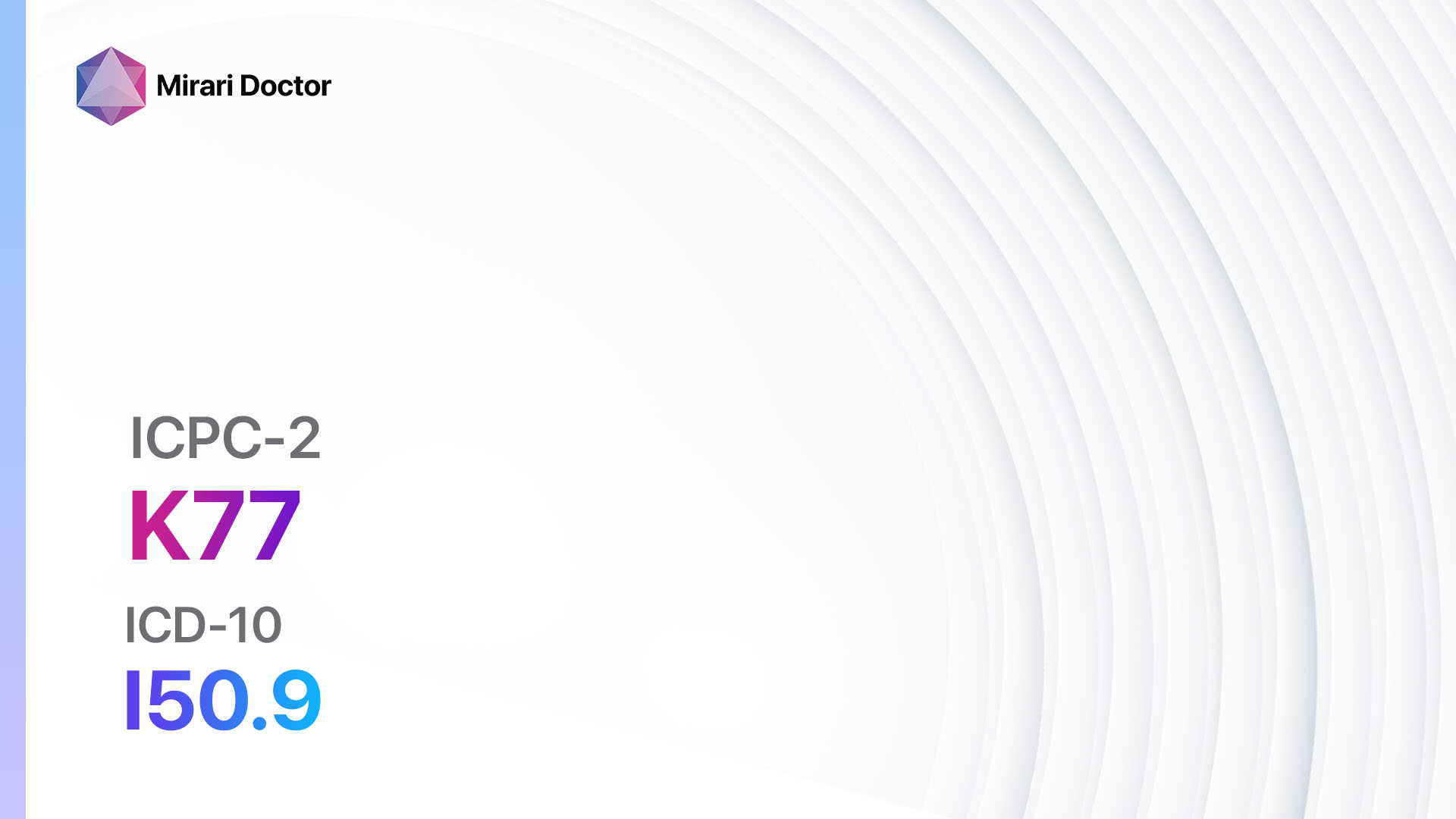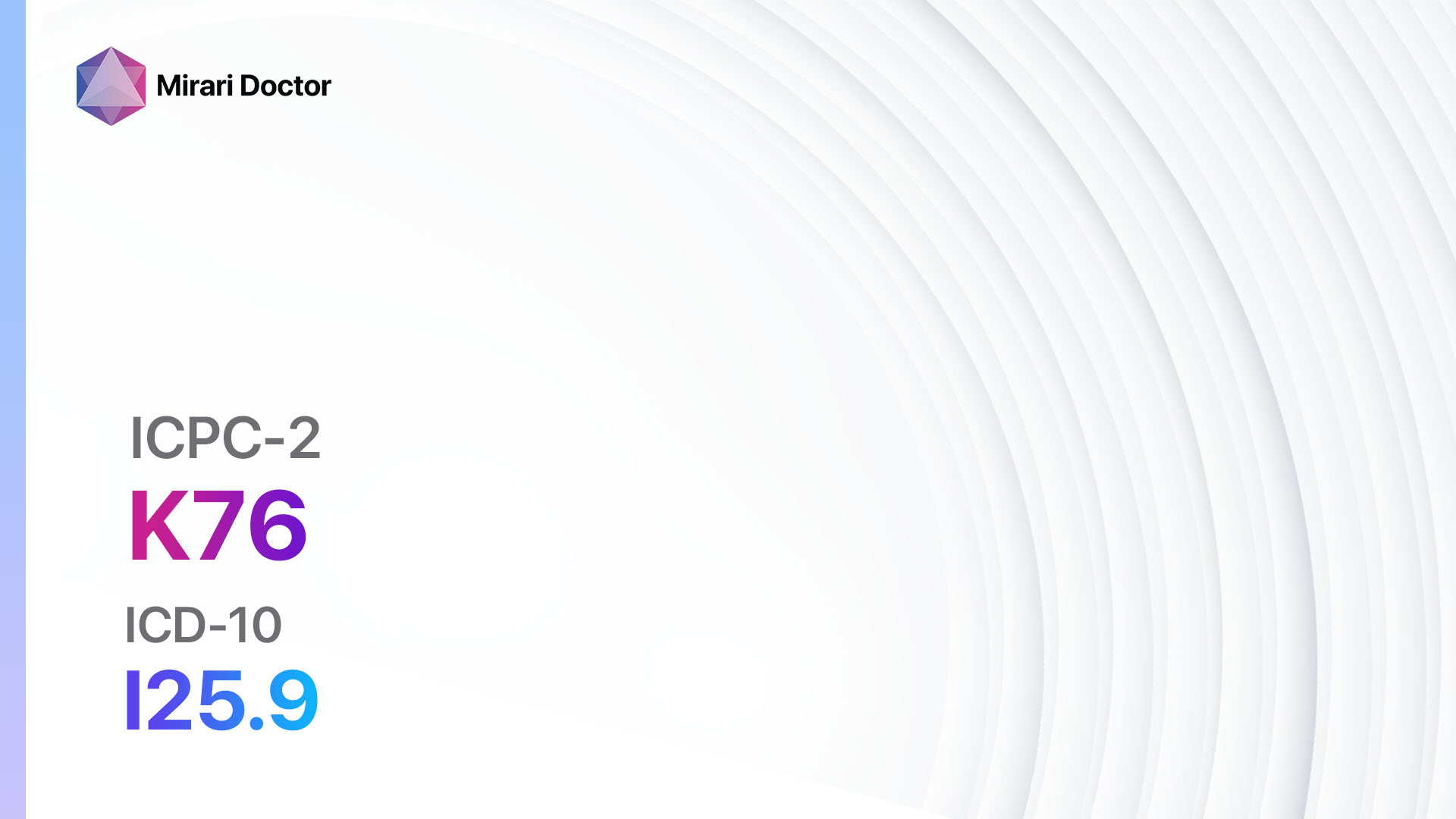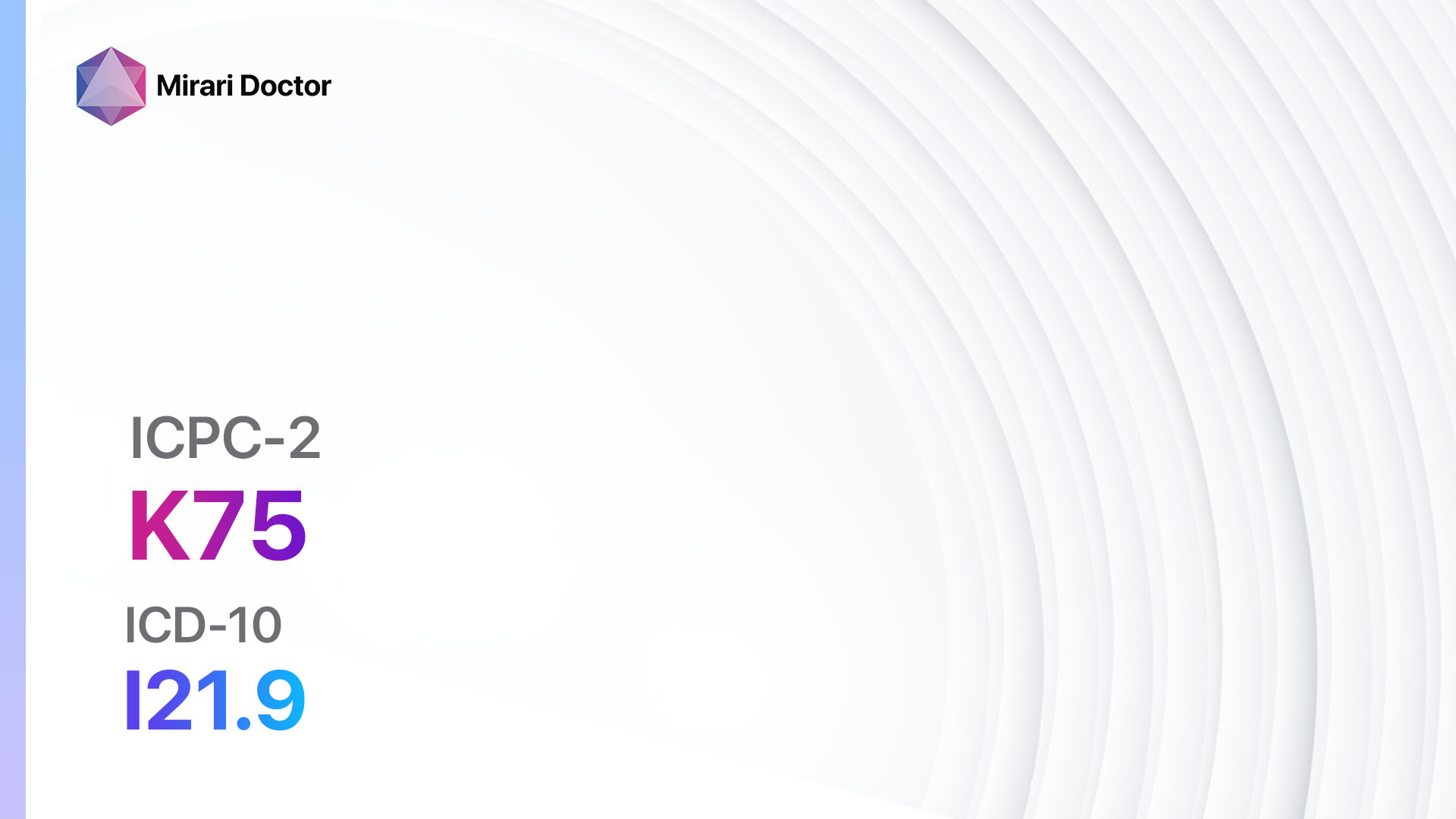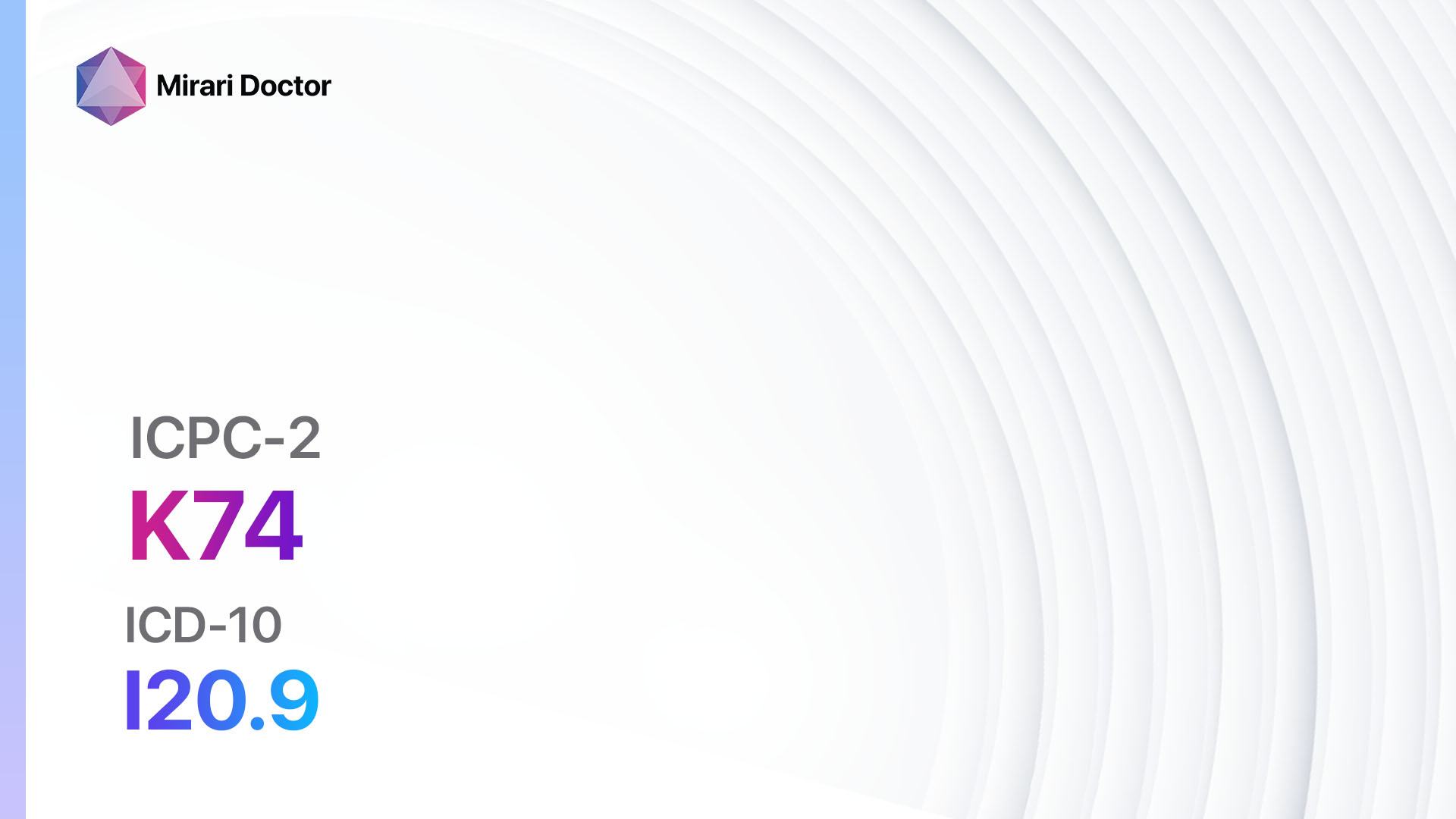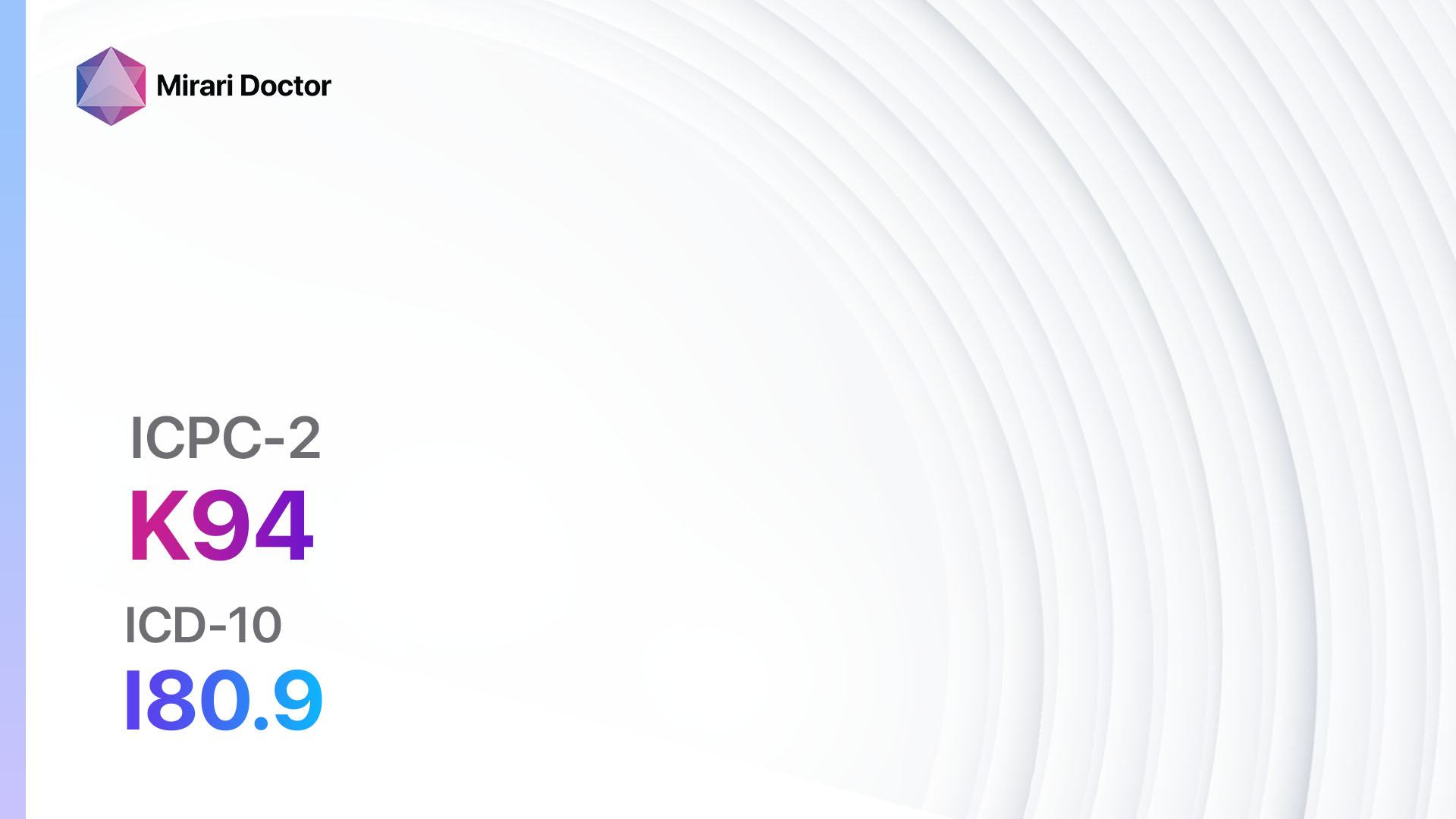
Introduction
Phlebitis/thrombophlebitis is a condition characterized by inflammation of a vein, often accompanied by the formation of a blood clot[1]. It can occur in both superficial veins (superficial phlebitis) and deep veins (deep vein thrombosis)[2]. This guide aims to provide an overview of the symptoms, causes, diagnostic steps, possible interventions, and lifestyle interventions for phlebitis/thrombophlebitis.
Codes
- ICPC-2 Code: K94 Phlebitis/thrombophlebitis[3]
- ICD-10 Code: I80.9 Phlebitis and thrombophlebitis of unspecified site[4]
Symptoms
- Redness and warmth over the affected vein
- Swelling and tenderness
- Pain or discomfort, especially when walking or standing
- Palpable cord-like vein
- Skin discoloration or ulceration in severe cases[5]
Causes
- Trauma or injury to the vein
- Prolonged immobility
- Intravenous catheterization
- Varicose veins
- Blood clotting disorders
- Infection[6]
Diagnostic Steps
Medical History
- Gather information about the patient’s risk factors, such as recent surgeries, prolonged immobility, or a history of blood clotting disorders.
- Ask about symptoms, including pain, swelling, and redness in the affected area.
- Inquire about any recent trauma or injury to the vein.[7]
Physical Examination
- Inspect the affected area for redness, warmth, swelling, and tenderness.
- Palpate the vein to check for cord-like structures or hardness.
- Assess the patient’s overall condition, including vital signs and signs of infection.[8]
Laboratory Tests
- Complete blood count (CBC) to check for elevated white blood cell count, indicating infection.
- D-dimer test to assess for the presence of blood clots.
- Coagulation profile to evaluate the patient’s clotting ability.[9]
Diagnostic Imaging
- Doppler ultrasound to visualize blood flow and detect the presence of blood clots.
- Venography, a contrast dye study, to identify the location and extent of the clot.[10]
Other Tests
- Genetic testing for inherited blood clotting disorders.
- Cultures of the affected area to identify any underlying infections.
Follow-up and Patient Education
- Schedule follow-up appointments to monitor the patient’s progress and response to treatment.
- Educate the patient about the importance of compliance with medications and lifestyle modifications.
- Provide information on signs and symptoms of complications, such as pulmonary embolism, and when to seek immediate medical attention.
Possible Interventions
Traditional Interventions
Medications:
Top 5 drugs for Phlebitis/Thrombophlebitis:
- Nonsteroidal anti-inflammatory drugs (NSAIDs) (e.g., Ibuprofen, Naproxen):
- Cost: Generic versions can be $3-$20/month.
- Contraindications: Active peptic ulcer disease, history of gastrointestinal bleeding, severe renal impairment.
- Side effects: Upset stomach, gastrointestinal bleeding, kidney problems.
- Severe side effects: Allergic reactions, liver damage, heart problems.
- Drug interactions: Anticoagulants, corticosteroids, selective serotonin reuptake inhibitors (SSRIs).
- Warning: Prolonged use may increase the risk of cardiovascular events.
- Anticoagulants (e.g., Heparin, Warfarin):
- Cost: Heparin is $10-$100/month. Warfarin is $4-$20/month.
- Contraindications: Active bleeding, history of heparin-induced thrombocytopenia, severe liver disease.
- Side effects: Bleeding, bruising, hair loss.
- Severe side effects: Severe bleeding, allergic reactions, osteoporosis.
- Drug interactions: Many medications, including antibiotics, antifungals, and herbal supplements.
- Warning: Regular monitoring of blood clotting parameters is required.
- Thrombolytics (e.g., Alteplase, Reteplase):
- Cost: $2,000-$5,000 per dose.
- Contraindications: Active bleeding, recent surgery or trauma, history of stroke.
- Side effects: Bleeding, allergic reactions, fever.
- Severe side effects: Severe bleeding, intracranial hemorrhage.
- Drug interactions: Anticoagulants, antiplatelet agents.
- Warning: Should only be used in specific cases of severe thrombosis.
- Pain relievers (e.g., Acetaminophen, Tramadol):
- Cost: Generic versions can be $3-$20/month.
- Contraindications: Severe liver disease, history of alcoholism or drug addiction.
- Side effects: Upset stomach, liver damage (with high doses of acetaminophen), drowsiness (with tramadol).
- Severe side effects: Allergic reactions, liver failure (with high doses of acetaminophen), seizures (with tramadol).
- Drug interactions: Many medications, including anticoagulants and antidepressants.
- Warning: Avoid exceeding the recommended dose of acetaminophen to prevent liver damage.
- Antibiotics (e.g., Cephalexin, Clindamycin):
- Cost: Generic versions can be $4-$30/month.
- Contraindications: Allergy to the specific antibiotic, history of severe allergic reactions.
- Side effects: Upset stomach, diarrhea, rash.
- Severe side effects: Severe allergic reactions, Clostridium difficile infection.
- Drug interactions: Many medications, including anticoagulants and oral contraceptives.
- Warning: Take the full course of antibiotics as prescribed to prevent antibiotic resistance.
Alternative Drugs:
- Pentoxifylline: Improves blood flow and reduces inflammation. Cost: $20-$50/month.
- Hirudin: A direct thrombin inhibitor used in specific cases. Cost: $500-$1,000 per dose.
- Rivaroxaban: An anticoagulant used for the prevention of deep vein thrombosis. Cost: $300-$500/month.
- Danaparoid: An anticoagulant used in patients with heparin-induced thrombocytopenia. Cost: $1,000-$2,000 per dose.
- Aspirin: An antiplatelet agent that may be used in certain cases. Cost: \<$10/month.
Surgical Procedures:
- Thrombectomy: Surgical removal of the blood clot. Cost: $10,000-$30,000.
- Vein ligation and stripping: Surgical removal of the affected vein. Cost: $5,000-$15,000.
- Catheter-directed thrombolysis: Use of a catheter to deliver thrombolytic medication directly to the clot. Cost: $15,000-$50,000.
- Vein bypass surgery: Creation of a bypass around the blocked vein. Cost: $20,000-$50,000.
- Endovenous laser treatment: Use of laser energy to close off the affected vein. Cost: $3,000-$7,000.
Alternative Interventions
- Compression stockings: Improve blood flow and reduce swelling. Cost: $30-$100 per pair.
- Elevation of the affected limb: Helps reduce swelling and improve blood flow. Cost: Free.
- Regular exercise: Promotes blood circulation and reduces the risk of blood clots. Cost: Varies (gym membership, equipment, etc.).
- Herbal supplements: Some herbs, such as horse chestnut and butcher’s broom, may have potential benefits for reducing inflammation and improving circulation. Cost: Varies depending on the specific supplement.
- Acupuncture: May help improve blood flow and reduce pain. Cost: $60-$120 per session.
Lifestyle Interventions
- Weight loss: Reduces the strain on veins and improves blood flow. Cost: Varies (diet programs, gym membership, etc.).
- Regular physical activity: Promotes blood circulation and reduces the risk of blood clots. Cost: Varies (gym membership, equipment, etc.).
- Avoiding prolonged sitting or standing: Helps prevent blood pooling and reduces the risk of blood clots. Cost: Free.
- Smoking cessation: Smoking damages blood vessels and increases the risk of blood clots. Cost: Varies (nicotine replacement therapy, counseling, etc.).
- Healthy diet: A diet rich in fruits, vegetables, and whole grains promotes overall cardiovascular health. Cost: Varies depending on food choices.
It is important to note that the cost ranges provided are approximate and may vary depending on the location and availability of the interventions.
Mirari Cold Plasma Alternative Intervention
Understanding Mirari Cold Plasma
- Safe and Non-Invasive Treatment: Mirari Cold Plasma is a safe and non-invasive treatment option for various skin conditions. It does not require incisions, minimizing the risk of scarring, bleeding, or tissue damage.
- Efficient Extraction of Foreign Bodies: Mirari Cold Plasma facilitates the removal of foreign bodies from the skin by degrading and dissociating organic matter, allowing easier access and extraction.
- Pain Reduction and Comfort: Mirari Cold Plasma has a local analgesic effect, providing pain relief during the treatment, making it more comfortable for the patient.
- Reduced Risk of Infection: Mirari Cold Plasma has antimicrobial properties, effectively killing bacteria and reducing the risk of infection.
- Accelerated Healing and Minimal Scarring: Mirari Cold Plasma stimulates wound healing and tissue regeneration, reducing healing time and minimizing the formation of scars.
Mirari Cold Plasma Prescription
Video instructions for using Mirari Cold Plasma Device – K94 Phlebitis/thrombophlebitis (ICD-10:I80.9)
| Mild | Moderate | Severe |
| Mode setting: 1 (Infection) Location: 5 (Lungs) Morning: 15 minutes, Evening: 15 minutes | Mode setting: 1 (Infection) Location: 5 (Lungs) Morning: 30 minutes, Lunch: 30 minutes, Evening: 30 minutes | Mode setting: 1 (Infection) Location: 5 (Lungs) Morning: 30 minutes, Lunch: 30 minutes, Evening: 30 minutes |
| Mode setting: 2 (Wound Healing) Location: 5 (Lungs) Morning: 15 minutes, Evening: 15 minutes | Mode setting: 2 (Wound Healing) Location: 5 (Lungs) Morning: 30 minutes, Lunch: 30 minutes, Evening: 30 minutes | Mode setting: 2 (Wound Healing) Location: 5 (Lungs) Morning: 30 minutes, Lunch: 30 minutes, Evening: 30 minutes |
| Mode setting: 7 (Immunotherapy) Location: 1 (Sacrum) Morning: 15 minutes, Evening: 15 minutes | Mode setting: 7 (Immunotherapy) Location: 1 (Sacrum) Morning: 30 minutes, Lunch: 30 minutes, Evening: 30 minutes | Mode setting: 7 (Immunotherapy) Location: 1 (Sacrum) Morning: 30 minutes, Lunch: 30 minutes, Evening: 30 minutes |
| Mode setting:7 (Immunotherapy) Location:4 (Heart, Bile & Pancreas) Morning: 15 minutes, Evening: 15 minutes | Mode setting:7 (Immunotherapy) Location:4 (Heart, Bile & Pancreas) Morning: 30 minutes, Lunch: 30 minutes, Evening: 30 minutes | Mode setting:7 (Immunotherapy) Location:4 (Heart, Bile & Pancreas) Morning: 30 minutes, Lunch: 30 minutes, Evening: 30 minutes |
| Total Morning:60minutesapprox.$10USD, Evening:60minutesapprox.$10USD | Total Morning:120minutesapprox.$20USD, Lunch:120minutesapprox. $20 USD, Evening:120minutesapprox. $20 USD, | Total Morning:120minutesapprox.$20USD, Lunch:120minutesapprox. $20 USD, Evening:120minutesapprox. $20 USD, |
| Usualtreatmentfor7-60daysapprox.$140USD–$1200USD | Usualtreatmentfor6-8weeksapprox.$2,520USD–$3,360USD | Usualtreatmentfor3-6monthsapprox.$5,400USD–$10,800USD |
 |
|
Use the Mirari Cold Plasma device to treat Phlebitis/thrombophlebitis effectively.
WARNING: MIRARI COLD PLASMA IS DESIGNED FOR THE HUMAN BODY WITHOUT ANY ARTIFICIAL OR THIRD PARTY PRODUCTS. USE OF OTHER PRODUCTS IN COMBINATION WITH MIRARI COLD PLASMA MAY CAUSE UNPREDICTABLE EFFECTS, HARM OR INJURY. PLEASE CONSULT A MEDICAL PROFESSIONAL BEFORE COMBINING ANY OTHER PRODUCTS WITH USE OF MIRARI.
Step 1: Cleanse the Skin
- Start by cleaning the affected area of the skin with a gentle cleanser or mild soap and water. Gently pat the area dry with a clean towel.
Step 2: Prepare the Mirari Cold Plasma device
- Ensure that the Mirari Cold Plasma device is fully charged or has fresh batteries as per the manufacturer’s instructions. Make sure the device is clean and in good working condition.
- Switch on the Mirari device using the power button or by following the specific instructions provided with the device.
- Some Mirari devices may have adjustable settings for intensity or treatment duration. Follow the manufacturer’s instructions to select the appropriate settings based on your needs and the recommended guidelines.
Step 3: Apply the Device
- Place the Mirari device in direct contact with the affected area of the skin. Gently glide or hold the device over the skin surface, ensuring even coverage of the area experiencing.
- Slowly move the Mirari device in a circular motion or follow a specific pattern as indicated in the user manual. This helps ensure thorough treatment coverage.
Step 4: Monitor and Assess:
- Keep track of your progress and evaluate the effectiveness of the Mirari device in managing your Phlebitis/thrombophlebitis. If you have any concerns or notice any adverse reactions, consult with your health care professional.
Note
This guide is for informational purposes only and should not replace the advice of a medical professional. Always consult with your healthcare provider or a qualified medical professional for personal advice, diagnosis, or treatment. Do not solely rely on the information presented here for decisions about your health. Use of this information is at your own risk. The authors of this guide, nor any associated entities or platforms, are not responsible for any potential adverse effects or outcomes based on the content.
Mirari Cold Plasma System Disclaimer
- Purpose: The Mirari Cold Plasma System is a Class 2 medical device designed for use by trained healthcare professionals. It is registered for use in Thailand and Vietnam. It is not intended for use outside of these locations.
- Informational Use: The content and information provided with the device are for educational and informational purposes only. They are not a substitute for professional medical advice or care.
- Variable Outcomes: While the device is approved for specific uses, individual outcomes can differ. We do not assert or guarantee specific medical outcomes.
- Consultation: Prior to utilizing the device or making decisions based on its content, it is essential to consult with a Certified Mirari Tele-Therapist and your medical healthcare provider regarding specific protocols.
- Liability: By using this device, users are acknowledging and accepting all potential risks. Neither the manufacturer nor the distributor will be held accountable for any adverse reactions, injuries, or damages stemming from its use.
- Geographical Availability: This device has received approval for designated purposes by the Thai and Vietnam FDA. As of now, outside of Thailand and Vietnam, the Mirari Cold Plasma System is not available for purchase or use.
References
- Spitaels D, Mamouris P, Vaes B, et al. Epidemiology of venous thromboembolism in primary care: a retrospective cohort study. BMJ Open. 2020;10(1):e031734. Published 2020 Jan 19. doi:10.1136/bmjopen-2019-031734
- Schünemann HJ, Cushman M, Burnett AE, et al. American Society of Hematology 2018 guidelines for management of venous thromboembolism: prophylaxis for hospitalized and nonhospitalized medical patients. Blood Adv. 2018;2(22):3198-3225. doi:10.1182/bloodadvances.2018022954
- WONCA International Classification Committee. ICPC-2: International Classification of Primary Care. 2nd ed. Oxford: Oxford University Press; 1998.
- World Health Organization. ICD-10: international statistical classification of diseases and related health problems: tenth revision, 2nd ed. World Health Organization; 2004.
- Di Nisio M, Wichers IM, Middeldorp S. Treatment for superficial thrombophlebitis of the leg. Cochrane Database Syst Rev. 2018;2(2):CD004982. Published 2018 Feb 25. doi:10.1002/14651858.CD004982.pub6
- Mazzolai L, Aboyans V, Ageno W, et al. Diagnosis and management of acute deep vein thrombosis: a joint consensus document from the European Society of Cardiology working groups of aorta and peripheral vascular diseases and pulmonary circulation and right ventricular function. Eur Heart J. 2018;39(47):4208-4218. doi:10.1093/eurheartj/ehx003
- Scovell S. Phlebitis and thrombosis of the superficial lower extremity veins. UpToDate. Updated April 2021. Accessed June 21, 2024.//www.uptodate.com/contents/phlebitis-and-thrombosis-of-the-superficial-lower-extremity-veins
- Bauersachs R, Gerlach H, Rabe E, et al. S2k Guideline: Diagnosis and Treatment of Superficial Vein Thrombosis (AWMF 037/011 (S2k)). Vasa. 2021;50(2):133-144. doi:10.1024/0301-1526/a000920
- Bates SM, Jaeschke R, Stevens SM, et al. Diagnosis of DVT: Antithrombotic Therapy and Prevention of Thrombosis, 9th ed: American College of Chest Physicians Evidence-Based Clinical Practice Guidelines. Chest. 2012;141(2 Suppl):e351S-e418S. doi:10.1378/chest.11-2299
- Needleman L, Cronan JJ, Lilly MP, et al. Ultrasound for Lower Extremity Deep Venous Thrombosis: Multidisciplinary Recommendations From the Society of Radiologists in Ultrasound Consensus Conference. Circulation. 2018;137(14):1505-1515. doi:10.1161/CIRCULATIONAHA.117.030687
Related articles
Made in USA


